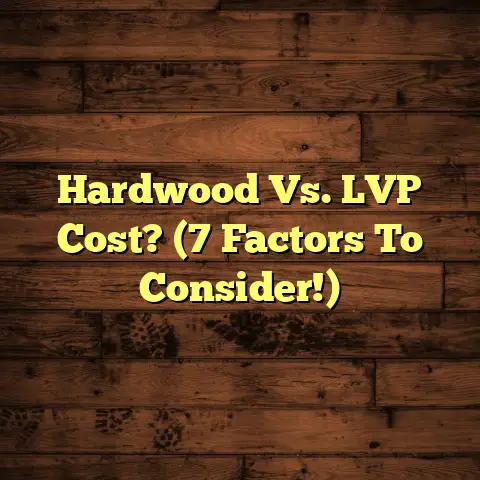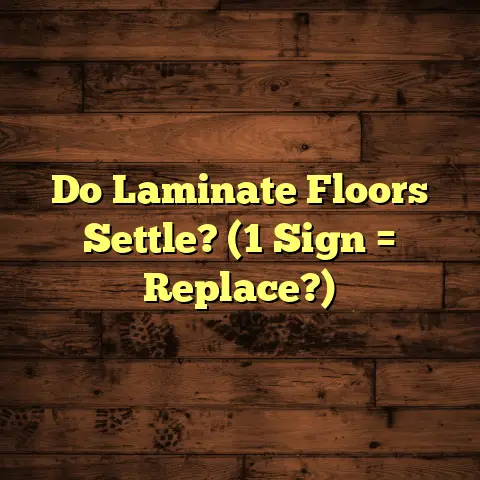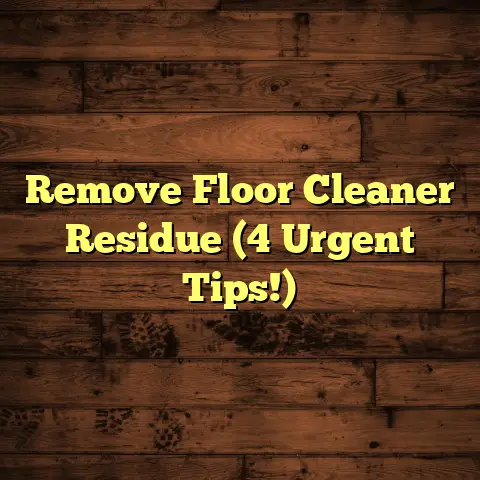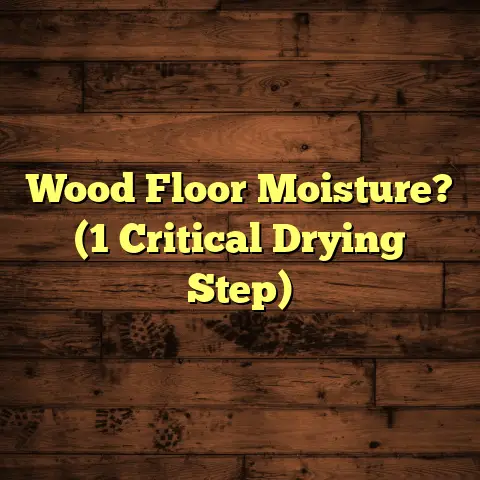Scratch-Resistant Hardwood? (4 Must Know Facts!)
I’ve seen it all, from disastrous DIY attempts to stunning transformations.
And lately, I’ve been getting asked a lot about scratch-resistant hardwood.
With the growing buzz around eco-friendly living, folks want floors that look great, last long, and are kind to the planet.
Hardwood floors have always been a top choice, right? Timeless beauty, adds value to your home…
But the scratch factor? That’s been a concern.
Well, good news! Technology has stepped up, giving us more resilient options than ever before.
Let’s dive into four must-know facts about scratch-resistant hardwood!
Section 1: Understanding Scratch-Resistant
Hardwood
So, what exactly is scratch-resistant hardwood?
It’s not magic, but it’s pretty close! Essentially, it’s hardwood flooring engineered to withstand more wear and tear than traditional options.
Think of it as hardwood with a superpower.
The secret lies in a combination of factors: the finish, the wood species, and the manufacturing process.
The Technology Behind It
The key is often in the finish. We’re talking about tough coatings like aluminum oxide.
This stuff is hard. It’s baked onto the wood during manufacturing, creating a protective shield.
Think of it like the clear coat on your car. It’s there to take the beating so the paint underneath stays pristine.
Other protective layers might include multiple coats of polyurethane with scratch-resistant additives.
These additives help to deflect minor abrasions and keep your floors looking newer for longer.
Treatments and Finishes
You’ve got options galore!
-
Aluminum Oxide: As I mentioned, this is a heavy-duty option. It’s incredibly durable and long-lasting.
-
Ceramic Finishes: These finishes incorporate ceramic particles for added strength and scratch resistance.
-
UV-Cured Acrylic Finishes: These finishes are cured under ultraviolet light, creating a tough, durable surface.
-
Fortified Polyurethane: Standard polyurethane can be enhanced with additives to improve its scratch resistance.
The Importance of Species Selection
Not all wood is created equal!
Some species are naturally harder than others. This is measured using the Janka hardness scale.
Check out this table for some common hardwood species and their Janka ratings:
| Wood Species | Janka Hardness |
|---|---|
| Brazilian Cherry | 2350 |
| Hickory | 1820 |
| Hard Maple | 1450 |
| Red Oak | 1290 |
| White Oak | 1360 |
| American Cherry | 950 |
| American Walnut | 1010 |
| Douglas Fir | 660 |
| Southern Yellow Pine | 870 |
Source: National Wood Flooring Association (NWFA)
As you can see, Brazilian Cherry is significantly harder than American Cherry.
So, if you’re looking for maximum scratch resistance, opt for a harder species.
Hickory and Maple are also excellent choices.
However, keep in mind that even the hardest wood can still be scratched under the right circumstances.
The Manufacturing Process
The manufacturing process also plays a crucial role.
High-quality scratch-resistant hardwood is often engineered with multiple layers.
This construction adds stability and helps to prevent warping and cupping.
The finish is applied in a controlled environment, ensuring even coverage and proper curing.
This attention to detail is what separates truly scratch-resistant hardwood from the less effective alternatives.
Section 2: Advantages of Scratch-Resistant
Hardwood
Okay, so we know what it is. But why should you care?
Let’s talk advantages!
Durability, Longevity, and Maintenance Ease
The big one, obviously, is durability.
Scratch-resistant hardwood is designed to withstand the daily grind.
Think about it: pets running around, kids playing with toys, furniture being moved…
Traditional hardwood can quickly show signs of wear and tear.
But scratch-resistant hardwood holds up much better.
This means your floors will look newer for longer, saving you money on refinishing or replacement.
And let’s not forget about maintenance!
Scratch-resistant floors are typically easier to clean. A quick sweep or mop is usually all it takes.
You won’t have to worry as much about babying them.
Ideal for Homes with Pets and Children
If you have pets or children, you know the struggle is real.
Scratches and dents are practically inevitable.
But with scratch-resistant hardwood, you can breathe a little easier.
Your furry friends can frolic without you constantly worrying about their claws.
Your kids can play without you having to hover over them with a dustpan and brush.
It’s a win-win!
Aesthetic Advantages
Let’s be honest, we all want floors that look good.
Scratch-resistant hardwood doesn’t just offer practical benefits; it also retains its beauty over time.
You won’t have to deal with unsightly scratches and scuffs that detract from the overall appearance of your home.
Your floors will continue to look stunning for years to come, adding value and style to your living space.
Statistical Data and Studies
While specific statistics on “scratch-resistant” hardwood are limited (as it’s a marketing term), studies on the Janka hardness scale and finish durability provide valuable insights.
For example, a study by the Forest Products Laboratory found that floors with aluminum oxide finishes had significantly higher abrasion resistance than those with traditional polyurethane finishes.
Anecdotally, I’ve seen clients who switched to scratch-resistant options report significantly fewer visible scratches after years of use, compared to their previous hardwood floors.
Section 3: The Environmental Impact of
Scratch-Resistant Hardwood
Now, let’s talk about the planet.
We all want to make responsible choices, and that includes flooring.
Sustainability of Hardwood Flooring
Hardwood can be a sustainable choice, if it’s sourced responsibly.
Look for wood that’s certified by the Forest Stewardship Council (FSC).
This means the wood comes from forests that are managed in an environmentally and socially responsible manner.
Avoiding deforestation and promoting biodiversity.
Also, consider reclaimed hardwood.
This is wood that’s been salvaged from old buildings or other sources.
It’s a great way to give wood a second life and reduce the demand for new timber.
Environmentally Friendly Manufacturing
The manufacturing process of scratch-resistant hardwood can also be more environmentally friendly.
Some manufacturers use low-VOC (volatile organic compound) finishes, which are better for both your health and the environment.
They also implement waste reduction strategies to minimize their impact.
Lifecycle Impact
The durability of scratch-resistant hardwood contributes to its overall sustainability.
Because it lasts longer, you won’t have to replace it as often.
This reduces the amount of waste generated and lowers the carbon footprint associated with flooring materials.
Think about it: less manufacturing, less transportation, less disposal. It all adds up.
Eco-Friendly Finishes and Treatments
As I mentioned earlier, some finishes are more eco-friendly than others.
Look for water-based finishes with low VOC content.
These finishes are durable and scratch-resistant while minimizing harmful emissions.
Section 4: Choosing the Right Scratch-Resistant
Hardwood for Your Home
Alright, you’re sold on the idea. But how do you choose the right scratch-resistant hardwood for your home?
Considering Different Areas of the Home
Think about the specific needs of each room.
For high-traffic areas like hallways and living rooms, you’ll want a harder wood species and a more durable finish.
For bedrooms, you might be able to get away with a slightly softer wood.
Bathrooms require extra moisture resistance, so consider engineered hardwood with a waterproof core.
Proper Installation Techniques
Proper installation is crucial for the performance of any flooring, including scratch-resistant hardwood.
Make sure you hire a qualified installer who follows the manufacturer’s instructions carefully.
A properly installed floor will be more stable and less prone to scratches and dents.
Maintaining Your Floors
Even scratch-resistant hardwood requires some basic maintenance.
-
Sweep or vacuum regularly to remove dirt and debris.
-
Use a damp mop with a pH-neutral cleaner to clean the floors.
-
Avoid using harsh chemicals or abrasive cleaners.
-
Place mats at entrances to trap dirt and moisture.
-
Use furniture pads under heavy items to prevent scratches.
Common Misconceptions
Let’s clear up a few common misconceptions about hardwood flooring:
-
“All hardwood is the same.” Nope! As we discussed, different species have different hardness levels.
-
“Scratch-resistant means scratch-proof.” Unfortunately, no flooring is completely scratch-proof. But scratch-resistant hardwood is much more resistant than traditional options.
-
“Hardwood is too expensive.” While hardwood can be an investment, its longevity and durability make it a cost-effective choice in the long run.
Conclusion: The Future of Flooring
Scratch-resistant hardwood is more than just a trend; it’s a practical and responsible choice for modern homes.
It combines the timeless beauty of hardwood with the durability and sustainability that today’s homeowners demand.
By making informed choices about flooring, we can create living spaces that are both beautiful and environmentally conscious.
So, if you’re looking for a flooring option that offers style, durability, and environmental responsibility, I encourage you to explore the world of scratch-resistant hardwood.
It’s an investment you won’t regret!





